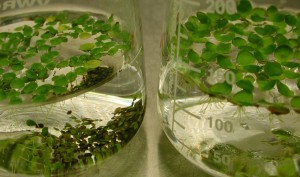The recently sequenced genome of Spirodela polyrhiza showcases why the plant makes an excellent raw source for biofuels.
The Science:
Duckweed is one of the smallest and fastest-growing flowering plants that can be a hard-to-control weed in ponds and small lakes. Sequencing the genome of Greater Duckweed (Spirodela polyrhiza) has provides clues about how the tiny plant can be used as an efficient biofuel raw material. It turns out to have one of the smallest plant genomes and is missing many genes, including those for plant maturation and production of cellulose and lignin. It has more genes than comparable plants for starch production.
The Impact:
Duckweed shows great promise as a biofuel feedstock. Private companies are already exploring using duckweed to produce fuel. Because of duckweed’s many unique traits (low cellulose and lignin production and high starch production) and life cycle, insights from its genome can tell us a lot about the genes are involved in production of cellulose and lignin. Removing these woody materials from feedstock has been a major challenge in biofuel production. Moreover, S. polyrhiza’s high starch content is also a desirable trait in biofuel feedstock.

Duckweed is a relatively simple plant with fronds that float on the surface of the water and roots that extend into the water. In the flask on the left, you can see the dormant phase, turions, that have dropped to the bottom. Photo by Wenquin Wang
Summary
Simple and primitive, a duckweed plant consists of a single small kidney-shaped leaf about the size of a pencil-top eraser that floats on the surface of the water with a few thin roots underwater. It often forms thick mats on the edges of ponds, quiet inlets of lakes and in marshes. It’s among the fastest growing plants, able to double its population in a couple of days under ideal conditions. These and other properties make it an ideal candidate as a biofuel feedstock – a raw source for biofuel production.
In a paper published February 19, 2014 in the journal Nature Communications, researchers from Rutgers University, the Department of Energy Joint Genome Institute and several other facilities detailed the complete genome of S. polyrhiza and analyzed it in comparison to several other plants, including rice and tomatoes. It’s genome was sequenced as part of a JGI Community Science Program (CSP) project (formerly the Community Sequencing Program).
S. polyrhiza turns out to have one of the smallest known plant genomes, at about 158 million base pairs and fewer than 20,000 protein-encoding genes. Unlike other plants, S. polyrhiza leaves never progress past the juvenile cotyledon stage. Not surprisingly, it has fewer genes to promote and more genes to repress the switch from juvenile to mature growth, compared to other plants. Many of the genes responsible for cellulose and lignin production in land dwelling plants were also missing, and there were fewer copies of those that were present. Genes for starch production, on the other hand, were retained.
Joaquim Messing of Rutgers University, senior author on the paper, estimates that duckweed will be a viable biofuel source within five years. Understanding which genes produce which traits will allow researchers to create new varieties of duckweed with enhanced biofuel traits.
Contact
Joachim Messing
Rutgers University
[email protected]
Publication
Wang W, et al. The Spirodela polyrhiza genome reveals insights into its neotenous reduction fast growth and aquatic lifestyle. Nature Communications 5:3311. 19 February 2014
doi:10.1038/ncomms4311
Funding
Department of Energy, Office of Science
Selman Waksman Chair in Molecular Genetics
Related Links
JGI News Release: Pond-dwelling powerhouse’s genome points to its biofuel potential
Video interview with Messing on the promise of duckweed: http://youtu.be/PLVPfoKw2rs
http://www.nature.com/ncomms/2014/140219/ncomms4311/full/ncomms4311.html